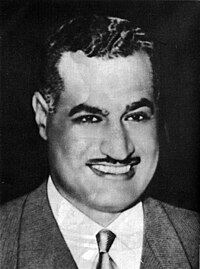United Arab Command
| Part of a series on the |
| Politics of the Arab world |
|---|
 |
The United Arab Command (UAC) (also Unified Arab Command or Joint Arab Command) was a unified Arab military command established by unanimous resolution of the thirteen member states of the Arab League at the summit held in Cairo, Egypt, on 13–16 January 1964.
Origins
Predecessors
The UAC was the culmination of a history of
Another pan-Arabist body, the
Background

The UAC was proposed by
The creation of the UAC was announced by Cairo Radio; no mention of the UAC was made in the official
Response
Arthur Lourie, Israeli ambassador to Britain, claimed that the establishment of the UAC had raised the tension in the region and had enabled Egypt to gain control over the military forces of its fellow Arab states.[10]
Organisation

The UAC was to be headed by an Egyptian lieutenant general, Ali Ali Amer,[5][11] and with headquarters in Cairo.[5] Notwithstanding the Egyptian bent to the UAC, its cost of creation, GBP 15 million, was mostly contributed by the oil-rich member states, with Saudi Arabia and Kuwait topping the list.[11]
Following the 1966
Tasks
An early task of the UAC was the
However, meaningful action by the UAC against Israel was given two pre-conditions by the commander-in-chief, Ali Ali Amer, at the second Arab League summit, held in Alexandria, Egypt, in September 1964. Firstly, the confrontation states – Lebanon, Jordan and Syria – must allow the UAC to station foreign Arab troops on their soil at the UAC's discretion.[13] Secondly, there must be co-ordination and standardisation of strategy, tactics, organisation and weaponry.[13] While the second pre-condition was agreed to in principle, the three confrontation states baulked at allowing Egyptian encroachment on their territory.[13]
Decline
Operation Shredder
The pre-conditions to military action set at the September 1964 Arab League summit proved insurmountable: in November 1966, the
Six-Day War
Following the
References
Bibliography
- Ashton, S. R.; Louis, William Roger, eds. (2004), East of Suez and the Commonwealth, 1964 - 1971: part 1: East of Suez, British documents on the end of empire: A, vol. 5, ISBN 0-11-290582-X
- Dasgupta, Punyapriya (1988). Cheated by the world: the Palestinian experience. New Delhi: Orient Longman Limited. ISBN 0-86131-827-7.
- Gat, Moshe (2003). Britain and the conflict in the Middle East, 1964 - 1967: the coming of the Six-Day War. ISBN 0-275-97514-2.
- Hof, Frederic C. (2000), "The water dimension of Golan Heights negotiations", in Amery, Hussein A.; Wolf, Aaron T. (eds.), Water in the Middle East: a geography of peace, University of Texas Press
- Oren, Michael B. (2002). Six days of war: June 1967 and the makings of the modern Middle East. New York: Oxford University Press.
- Salibi, Kamal (2006) [1993]. The modern history of Jordan. London: I. B. Tauris and Company Limited. ISBN 1-86064-331-0.
- Shemesh, Moshe (2003), "Arab strategy towards the Arab-Israeli conflict, January 1964 to June 1967", in Gammer, Moshe (ed.), Political thought and political history: studies in memory of Elie Kedourie, London: Frank Caas Publishers, ISBN 0-7146-5296-2
